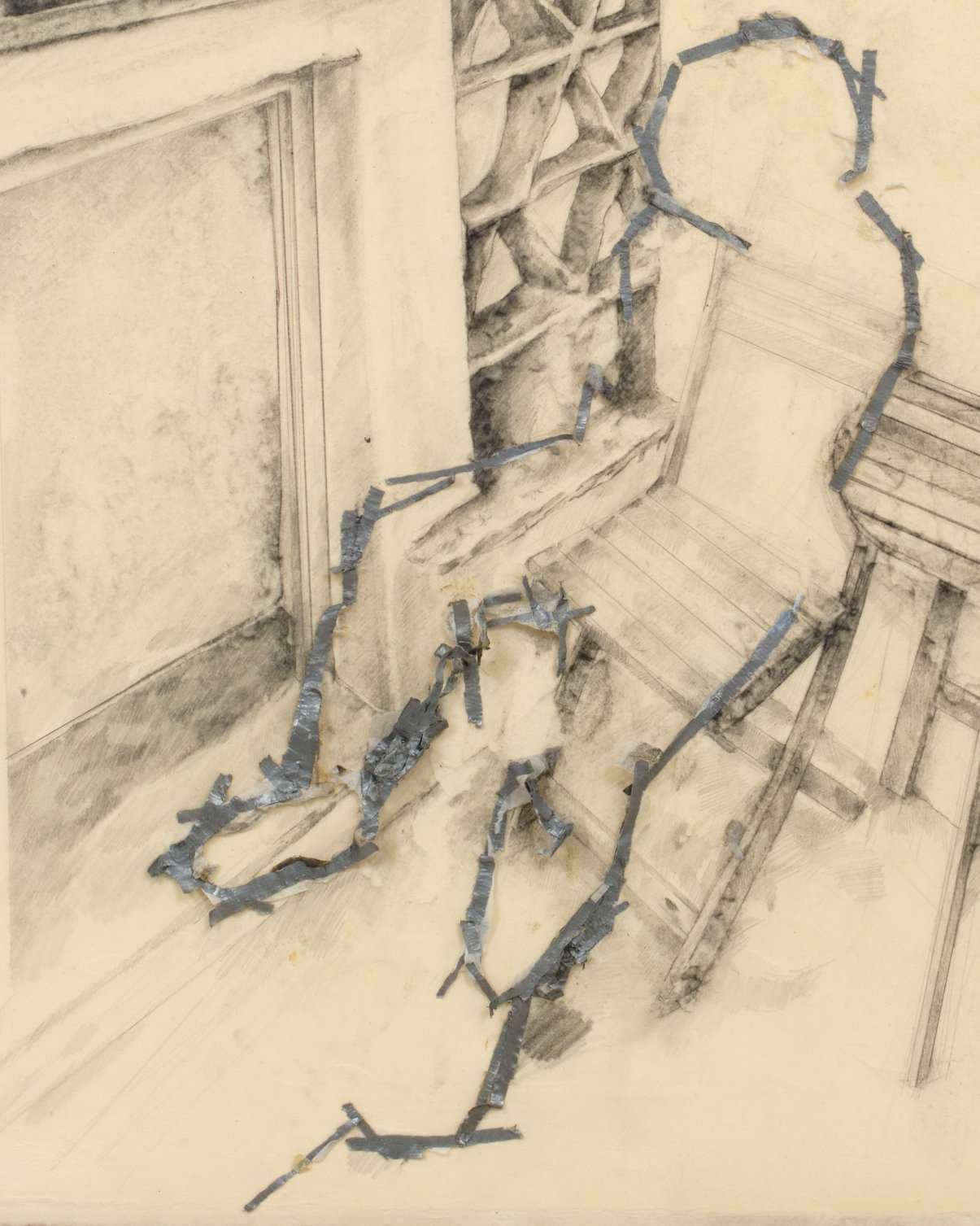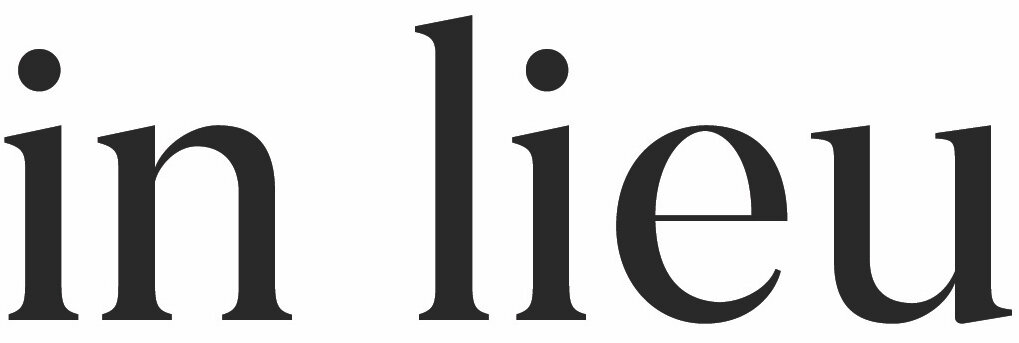Sophie Friedman-Pappas, Maren Karlson
Lacker
April 15 - May 20, 2023
In Lieu is pleased to announce Lacker, an exhibition of new work by Los Angeles-based artists Sophie Friedman-Pappas and Maren Karlson. Friedman-Pappas will display new installation and drawing works and Karlson will debut a suite of new oil paintings.
Let us begin at the intersection of a river called Saale and an island called Tinos. Don’t worry if you stumbled while reading – this intersection is fictive because both bodies are separated by a 2,500 km drive. The route crosses six national borders, bridges two different time zones, includes a two-hour ferry ride and about two dozen toll roads. Admittedly, it’s a bit of a stretch to call this a ‘crossing’. But if the hyperfictions of nations, tolls, and time zones withstand the suspension of disbelief, then so should the intersection of Saale and Tinos.
At this crossway you find yourself copulating with a putrid smell composed of two different types of waste: industrial goop and pigeon shit. The former emanates from a landfill brimming with household trash, ashes from power plants, construction rubble and toxic chemicals. Now imagine it’s a hot, sultry summer, and the soup that gathers in this dump leaks into the river. What is the river’s response? It produces a crown of foam, the kind aspired to in shampoo ads. The stage on which this scene takes place used to be known as ‘the Central German Chemical Triangle’.
The latter – pigeon shit – also shares a relation with triangles. More specifically with ‘deltille’, triangular tiling that owes its name to the English mathematician John Conway and the shape of the Greek letter delta. On the island of Tinos, deltilles form the intricate designs of its famous dovecotes – fortress-like stone structures dating back to the 18th and 19th century. Systematic pigeon-rearing arrived on the island with the conquest of the Cycladic Islands by the Venetians, who knew that pigeon faeces make for some first-class manure and helped turn the area into one of the most fertile around the country. Some dovecotes have been turned into holiday homes thanks to the vulture industry of Airbnb.
Speaking of vultures, Margaret Thatcher supposedly once said: ‘Standing in the middle of the road is very dangerous; you get knocked down by the traffic from both sides.’ If we – out of pure indulgence – entertain the idea that J.G. Ballard foresaw the rise of Thatcher when he wrote Crash as ‘an extreme metaphor for an extreme situation, a kit of desperate measures only for use in an extreme crisis’, then it was neoliberalism that bred the first pornographic novel about technology. ‘Pornography is the most political form of fiction’, he contends in the introduction to the 1995 edition of his novel, as ‘in a world ruled by fictions of every kind – mass-merchandising, advertising, politics conducted as a branch of advertising’, the only way to deal with reality is by treating it as complete fabrication – in other words, a work of art.
In The Miracle of Analogy, Kaja Silverman argues for the photographic image as analogy rather than representation or index; it develops ‘with us, and in response to us’; it is ‘the world’s primary way of revealing itself to us’. Although operating without the apparatus of the camera, painting or drawing also functions by way of analogy. The artist absorbs the world around her: rusty bottles, pipes outside her studio, newspaper images of rivers barely alive, X-rays, dovecotes, wide-angle photographs that make rental apartments always look larger than they actually are; when she excretes an artwork, she produces a relation — a triangle between herself, the world as fiction and the art of reality.
A few days ago, I saw a meme commemorating the ten-year anniversary of Thatcher’s passing, it ‘reformulated’ one of her famous quotes to say: ‘The problem with pissing on my grave is that you eventually run out of piss.’ I feel inclined to marry this meme with one of Theodor W. Adorno’s dreams, that must have been aroused by a strong desire to urinate while asleep. In this dream, anxious of not being able to control himself, he found a ‘large, white elegant lavatory in a grand hotel’, in which – to his disdain – preparations for a ‘ladies’ party’ were in train and ‘the urinals had been festooned with wreaths, flower arrangements and roses’, but nothing could stop him from relieving himself: ‘[T]he quantity of urine that flooded out of me turned out to be so vast that the bowl overflowed and flooded the entire banqueting hall. Without any end in sight, I awoke with a feeling of horror.’
Maybe you think all of this is nonsense, or nothing more than what Byung-Chul Han in The Agony of Eros condemns as ‘the pornographication of society’. However, when Han claims that sexuality is threatened by pornography, that porn profanes the erotic, and that the obscenity of pornography is not an excess of sex but ‘the fact that it contains no sex at all’, he must be holding on to some figment of a dream, a sacred ritual space for love and erotic seduction, for sex to exist without a fundamental negativity at its very core. Suddenly, you collide with a white convertible at the junction between Saale and Tinos.
You wake up from a dream with a tangle of dream-thoughts
which cannot be unravelled.
You reach down into the unknown
and what comes to the surface is
manifest desire.
All that is sacred is profaned,
and the only truth
is that of the incompleteness of being.
— Steph Holl-Trieu
Sophie Friedman-Pappas (b. 1995) is an artist who lives and works in Los Angeles, CA. She is currently working towards an MFA at University of California, Los Angeles. Friedman-Pappas has held a solo exhibition at Alyssa Davis (New York) and has participated in group exhibitions at Meredith Rosen (New York), Simone Subal (New York) and In Lieu (Los Angeles).
Maren Karlson (b. 1988) lives and works in Los Angeles. She is currently working towards an MFA at University of California, Los Angeles. Selected one and two person exhibitions include Soft Opening (London), Ashley (Berlin), Springsteen (Baltimore), in lieu (Los Angeles), 427 Gallery (Riga), and Interstate Projects (Brooklyn). Selected group exhibitions include Chapter (New York), François Ghebaly (Los Angeles), The Drawing Center (New York), Intersticio (Madrid), Futura (Prague), in lieu (Los Angeles), Fused / Jessica Silverman (San Francisco), among others.

Installation view of 'Lacker'.

MAREN KARLSON, "Heaven 1988", 2023, Oil on canvas, 24 x 77 inches (60 x 196 centimeters).

MAREN KARLSON, "Heaven 1988", 2023, Oil on canvas, 24 x 77 inches (60 x 196 centimeters).

Installation view of 'Lacker'.

MAREN KARLSON, "The Open", 2023, Oil on canvas, 7 x 8.5 inches (18 x 21.5 centimeters).

SOPHIE FRIEDMAN-PAPPAS & MAREN KARLSON, "Bottle", 2023, Found object, 4 x 7.5 x 4 inches (10 x 19 x 10 centimeters).

Installation view of 'Lacker'.

MAREN KARLSON, "Zäsur", 2023, Oil on canvas, 19.5 x 21 inches (50 x 53.5 centimeters).

Installation view of 'Lacker'.

SOPHIE FRIEDMAN-PAPPAS, "Deltille-d Wall's Necessary Anachronism 1", 2022-2023, Graphite, duct tape, and bird poop on Kozo paper in artist frame, 26 x 38 inches (unframed) / 28.75 x 40.75 inches (framed) [66 x 96,5 centimeters (unframed) / 73 x 103,5 centimeters (framed)].

SOPHIE FRIEDMAN-PAPPAS, Detail of "Deltille-d Wall's Necessary Anachronism 1", 2022-2023, Graphite, duct tape, and bird poop on Kozo paper in artist frame, 26 x 38 inches (unframed) / 28.75 x 40.75 inches (framed) [66 x 96,5 centimeters (unframed) / 73 x 103,5 centimeters (framed)].

MAREN KARLSON, "Unbound", 2023, Oil on canvas, 29.5 x 18 inches (75 x 45.5 centimeters).

Installation view of 'Lacker'.

MAREN KARLSON, "Canal", 2023, Oil on canvas, 8 x 55.5 inches (20 x 141 centimeters).

MAREN KARLSON, "Infinite Zero", 2023, Oil on canvas, 15.75 x 10 inches (40 x 25 centimeters).

Installation view of 'Lacker'.

SOPHIE FRIEDMAN-PAPPAS, Installation view of "Deltille-d Wall's Necessary Anachronism 2", 2023, Inverted camera obscura (homemade projector), mixed media, 10 minutes, Dimensions variable.

SOPHIE FRIEDMAN-PAPPAS, Detail of "Deltille-d Wall's Necessary Anachronism 2", 2023, Inverted camera obscura (homemade projector), mixed media, 10 minutes, Dimensions variable.

SOPHIE FRIEDMAN-PAPPAS, Detail of "Deltille-d Wall's Necessary Anachronism 2", 2023, Inverted camera obscura (homemade projector), mixed media, 10 minutes, Dimensions variable.

SOPHIE FRIEDMAN-PAPPAS, Detail of "Deltille-d Wall's Necessary Anachronism 2", 2023, Inverted camera obscura (homemade projector), mixed media, 10 minutes, Dimensions variable.

SOPHIE FRIEDMAN-PAPPAS, Detail of "Deltille-d Wall's Necessary Anachronism 2", 2023, Inverted camera obscura (homemade projector), mixed media, 10 minutes, Dimensions variable.

SOPHIE FRIEDMAN-PAPPAS, Detail of "Deltille-d Wall's Necessary Anachronism 2", 2023, Inverted camera obscura (homemade projector), mixed media, 10 minutes, Dimensions variable.

SOPHIE FRIEDMAN-PAPPAS, Detail of "Deltille-d Wall's Necessary Anachronism 2", 2023, Inverted camera obscura (homemade projector), mixed media, 10 minutes, Dimensions variable.

SOPHIE FRIEDMAN-PAPPAS, Installation view of "Deltille-d Wall's Necessary Anachronism 2", 2023, Inverted camera obscura (homemade projector), mixed media, 10 minutes, Dimensions variable.

SOPHIE FRIEDMAN-PAPPAS, Detail of "Deltille-d Wall's Necessary Anachronism 2", 2023, Inverted camera obscura (homemade projector), mixed media, 10 minutes, Dimensions variable.

SOPHIE FRIEDMAN-PAPPAS, Detail of "Deltille-d Wall's Necessary Anachronism 2", 2023, Inverted camera obscura (homemade projector), mixed media, 10 minutes, Dimensions variable.
